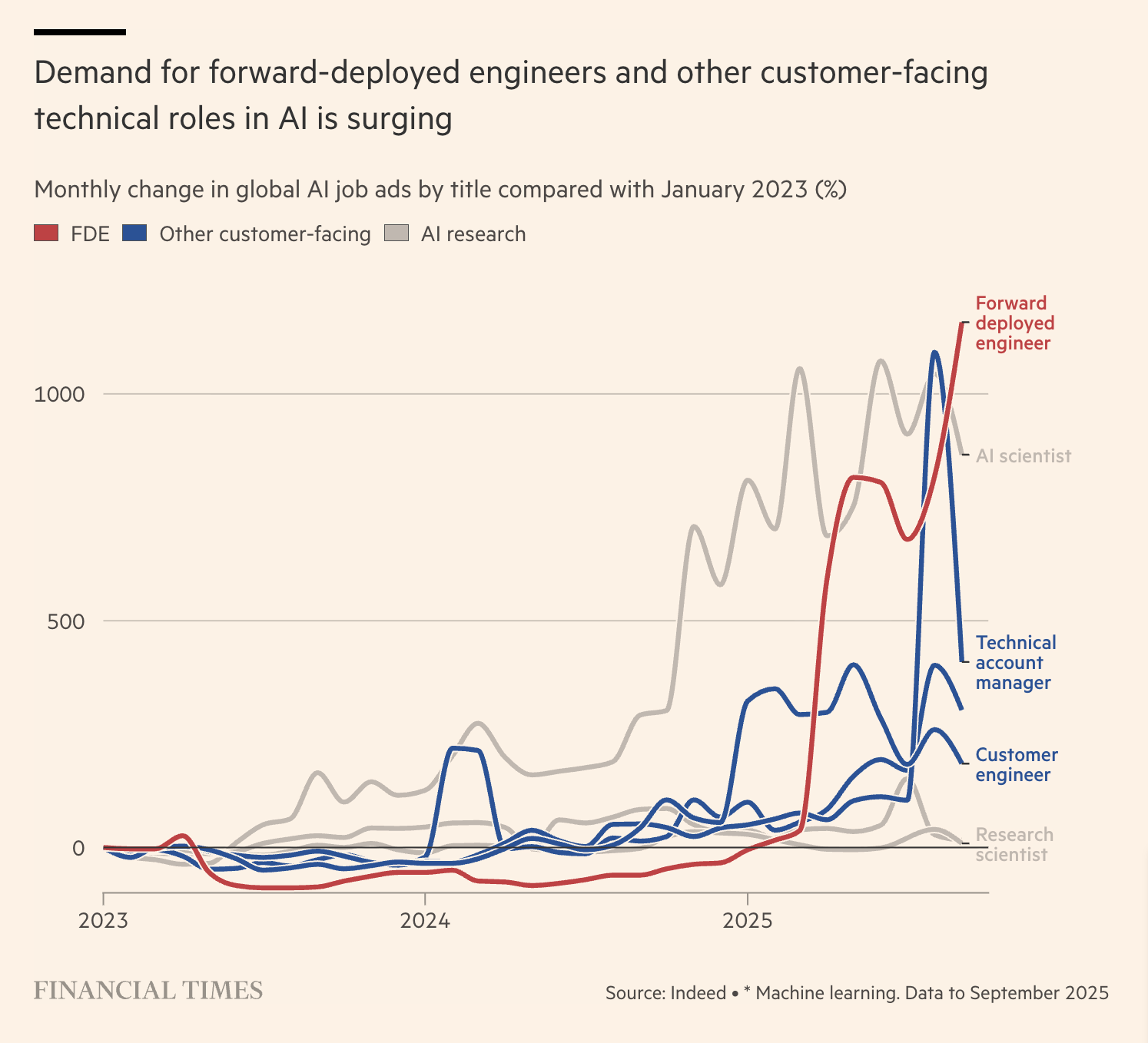A few weeks ago, this chart from the FT made the rounds:

SUBSCRIBE TO OUR NEWSLETTER
If you live around Silicon Valley or the software world, you’re starting to hear the term forward-deployed engineer (FDE) more and more. While the term has its roots in the military, it was popularized by Palantir over the last 20 years. To my mind, the primary distinction between a forward-deployed engineer and a more traditional software engineer is their relationship with customers. The latter is much more typically back-office, often purposely hidden away because of worry that they’re too technical or awkward for client interactions. Meanwhile, forward-deployed engineers are meant to sit within organizations, actually putting the software to work.
Nic Prettejohn, head of AI in the UK at Palantir, put it well in that FT piece: “[Forward-deployed engineers] know that the only valuable software is not how exquisite its code is or how beautiful the language . . . It’s only valuable if it means something for the end customer.”
At Alephic, we think about this a lot and have modeled some of our thinking on how Palantir operates. Like them, we have a core software engineering team that works on our platform: a set of tools and services that everyone can use to supercharge their work. This isn't SaaS—it's a set of techniques, components, scripts, and reference architectures we make available to our clients as part of our builds. We also have a team of forward-deployed engineers who work directly with customers to solve their problems.
One of the magical things about AI is that it can help to shrink the distance between these “builders” (our FDEs) and people who need things built. Gone are the days when you have four layers of "suits" sitting between engineers and customers. Those layers were sold as quality control and strategic oversight, but more often, they actually degraded quality while adding cost and delay. Each layer introduced translation errors, approval delays, political friction, context loss, and accountability diffusion. The builder never got to see the actual problem firsthand, and the customer never met the person building the solution.
By the time requirements traveled through four rounds of telephone, what got built bore little resemblance to what was needed. Nowhere is this better understood than the wasteland of enterprise software aimed at end-user employees but built for the work their managers imagine they do. I’d be lying if I said I never fell into this trap in my time at Percolate, building marketing SaaS for some of the biggest brands in the world. It’s natural to orient functionality towards the people who pay you, at the expense of the people who are expected to use the tool day in and day out.
Forward-deployed engineers collapse that distance. They sit with the customer, see the problem firsthand, and build the solution directly. Better quality, faster delivery, lower cost—not just because AI can help write code faster (it can), but because we've eliminated the organizational friction that was degrading all three.
If that last line sounds impossible, you're probably thinking of the iron triangle—the famous project management 'law' that says you have to choose two of speed, cost, and quality. While this held in the world of atoms, and even in traditional software development, I fundamentally believe that modern development principles have broken this constraint. I'm in good company here—here's what Patrick Collison, co-founder and CEO of Stripe, said in 2024:
Increasingly believe that the "good, cheap, fast—choose two" maxim is devious misinformation spread by the slow.
In my experience, "slow" and "expensive" usually go together. I was in a meeting yesterday where lopping a year off a project schedule also ended up reducing the cost substantially. Fundamentally, it takes time to spend, and adding the temporal constraint tends to make things simpler and more efficient.
I was on a call with a Fortune 100 CMO recently who asked why he was having a tingling sensation that the world of SaaS was fundamentally shifting beneath his feet. My argument was that AI enables us not just to build better software (because it can be custom-designed for the specific needs of the organization), but that, in turn, actually makes it cheaper and faster. While part of this is about the ability of AI to aid the coding process, much of it is actually just the fundamental capability of these models to replace large pieces of code that runs some brittle deterministic logic with a single call to a model that can often outperform thousands of lines of code.
But it's even bigger than that. AI is moving entire categories of previously unsolvable problems from meat space to cyberspace. Marketing challenges that used to live in the realm of human judgment and coordination can now be addressed with software development practices. This is why the ground is shifting beneath the CMO's feet.
All of these things are crashing together to create fundamentally new ways to solve problems across the enterprise. Obviously, this excitement is the force that pushed us to start Alephic, but it also more recently is the reason we started ForwardDeployed.com, a new podcast, media site, and community at the intersection of AI, software development, and the enterprise. Building on the success we’ve had with BRXND and Ride AI, we think that in this moment of AI, where computers become so much more capable, there’s also more room than ever to explore spaces that allow humans to connect, reflect, and think about the future. We hope you’ll subscribe and join us there.